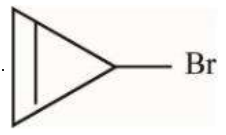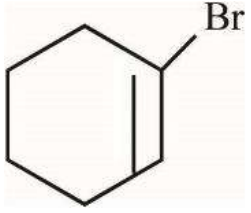Compound from the following that will not produce precipitate on reaction with AgNO3 is :




To solve the problem of which compound will not produce a precipitate when reacted with AgNO₃, we need to analyze the stability of the carbocations formed during the reaction. Here's a step-by-step solution:
Step 1: Understand the Reaction
When a compound reacts with AgNO₃, it typically involves the formation of a precipitate if a halide ion (like Cl⁻, Br⁻, or I⁻) is released. The reaction can be represented as:
R-X+AgNO3→R+AgX (precipitate)
where R is the organic group and X is the halide.
Step 2: Identify the Compounds
Let’s denote the four compounds as A, B, C, and D. We need to analyze each compound to determine the stability of the carbocation formed when the halide is eliminated.
Step 3: Analyze Carbocation Stability
1. Compound A: When the halide leaves, it forms a carbocation. If this carbocation is unstable (like a primary carbocation), the reaction will not proceed, and no precipitate will form.
2. Compound B: If the carbocation formed is secondary or tertiary, it is more stable, and the reaction will proceed, leading to a precipitate.
3. Compound C: Similar to compound B, if it forms a stable carbocation, a precipitate will form.
4. Compound D: If it also leads to a stable carbocation, it will produce a precipitate.
Step 4: Determine Which Compound Does Not React
After analyzing the stability of the carbocations:
- If Compound A forms an unstable carbocation, it will not react with AgNO₃, and thus no precipitate will form.
- The other compounds (B, C, and D) form stable carbocations and will produce precipitates.
Conclusion
The compound that will not produce a precipitate upon reaction with AgNO₃ is Compound A (the one that leads to an unstable carbocation).
When a compound reacts with AgNO₃, it typically involves the formation of a precipitate if a halide ion (like Cl⁻, Br⁻, or I⁻) is released. The reaction can be represented as:
R-X+AgNO3→R+AgX (precipitate)
where R is the organic group and X is the halide.
Let’s denote the four compounds as A, B, C, and D. We need to analyze each compound to determine the stability of the carbocation formed when the halide is eliminated.
1. Compound A: When the halide leaves, it forms a carbocation. If this carbocation is unstable (like a primary carbocation), the reaction will not proceed, and no precipitate will form.
2. Compound B: If the carbocation formed is secondary or tertiary, it is more stable, and the reaction will proceed, leading to a precipitate.
3. Compound C: Similar to compound B, if it forms a stable carbocation, a precipitate will form.
4. Compound D: If it also leads to a stable carbocation, it will produce a precipitate.
After analyzing the stability of the carbocations:
- If Compound A forms an unstable carbocation, it will not react with AgNO₃, and thus no precipitate will form.
- The other compounds (B, C, and D) form stable carbocations and will produce precipitates.
The compound that will not produce a precipitate upon reaction with AgNO₃ is Compound A (the one that leads to an unstable carbocation).
Topper's Solved these Questions
Similar Questions
Knowledge Check
Which of the following will produce a white precipitate upon reacting with AgNO3?
A[Co(NH3)6]Cl3B[Co(NH3)3Cl3]CK2[Pt(en)2Cl2]D[Fe(en)3]Cl3Which of the following will produce a white precipitate upon reacting with AgNO3?
A[Co(NH3)6]Cl3B[Co(NH3)3Cl3]CK2[Pt(en)2Cl2]D[Fe(en)3]Cl3Which of the following will not produce a precipitate with AgNO3 solution
AF−BBr−CCO2−3DPO3−4
Which of the following compounds will produce a precipitate with AgNO3 ?
View SolutionWhich of the following acid radicals produce white precipitate on addition of AgNO3 ?
View SolutionWhich of the following compounds will make precipitate most readily with AGNO3 ?
View SolutionAmong the following which compound gives precipitate with AgNO3 solution?
View SolutionWhich of the following will not give a precipitate with AgNO3 ?
View Solution
